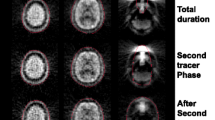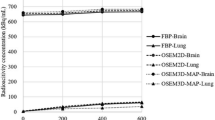Abstract
Objective
Regional cerebral blood flow (CBF), cerebral blood volume, oxygen extraction fraction (OEF), and cerebral metabolic rate of oxygen (CMRO2) can be estimated from C15O, H2 15O, and 15O2 tracers and positron emission tomography (PET) using an autoradiographic (ARG) method. Our objective in this study was to optimize the scan time for 15O2 gas study for accurate estimation of OEF and CMRO2.
Methods
We evaluated statistical noise in OEF by varying the scan time and error caused by the tissue heterogeneity in estimated OEF and CMRO2 using computer simulations. The characteristics of statistical noise were investigated by signal-to-noise (S/N) ratio from repeated tissue time activity curves with noise, which were generated using measured averaged arterial input function and assuming CBF = 20, 50, and 80 (ml/100 g per minute). Error caused by tissue heterogeneity was also investigated by estimated OEF and CMRO2 from tissue time activity curve with mixture of gray and white matter varying fraction of mixture. In the simulations, three conditions were assumed (i) CBF in gray and white matter (CBFg and CBFw) was 80 and 20, OEF in gray and white matter (E g and E w) was 0.4 and 0.3, (ii) CBFg and CBFw decreased by 50%, and E g and E w increased by 50% when compared with conditions (i) and (iii). CBFg and CBFw decreased by 80%, and E g and E w increased by 50% when compared with condition (i).
Results
The longer scan time produced the better S/N ratio of estimated OEF value from three CBF values (20, 50, and 80). Errors of estimated OEF for three conditions owing to tissue heterogeneity decreased, as scan time took longer. Meanwhile in the case of CMRO2, 3 min of scan time was desirable.
Conclusions
The optimal scan time of 15O2 inhalation study with the ARG method was concluded to be 3 min from taking into account for maintaining the S/N ratio and the quantification of accurate OEF and CMRO2.
Similar content being viewed by others
References
Ter-Pogossian MM, Herscovitch P. Radioactive oxygen-15 in the study of cerebral blood flow, blood volume, and oxygen metabolism. Semin Nucl Med 1985;15:377–394.
Baron JC, Bousser MG, Rey A, Guillard A, Comar D, Castaigne P. Reversal of focal “misery-perfusion syndrome” by extra-intracranial arterial bypass in hemodynamic cerebral ischemia: a case study with 15O positron emission tomography. Stroke 1981;12:454–459.
Gibbs JM, Wise RJ, Leenders KL, Jones T. Evaluation of cerebral perfusion reserve in patients with carotid-artery occlusion. Lancet 1984;11:310–314.
Mintun MA, Raichle ME, Martin WR, Herscovitch P. Brain oxygen utilization measured with O-15 radiotracers and positron emission tomography. J Nucl Med 1984;25:177–187.
Jones SC, Greenberg JH, Reivich M. Error analysis for the determination of cerebral blood flow with the continuous inhalation of 15O-labeled carbon dioxide and positoron emission tomograph. J Comput Assist Tomogr 1982;6:116–124.
Hatazawa J, Fujita H, Kanno I, Satoh T, Iida H, Miura S. Regional cerebral blood flow, blood volume, oxygen extraction fraction and oxygen utilization rate in normal volunteers measured by the autoradiographic and the single inhalation method. Ann Nucl Med 1995;9:15–21.
Kanno I, Iida H, Miura S, Murakami M. Optimal scan time of oxygen-15-labeled water injection method for measurement of cerebral blood flow. J Nucl Med 1991;32:1931–1934.
Ito H, Shidahara M, Inoue K, Goto R, Kinomura S, Taki Y, et al. Effects of tissue heterogeneity on cerebral vascular response to acetazolamide stress measured by an I-123-IMP autoradiographic method with single-photon emission computed tomography. Ann Nucl Med 2005;19:251–260.
Kanno I, Iida H, Miura S, Murakami M, Takahashi K, Sasaki H, et al. A system for cerebral blood flow measurement using an H2 15O autoradiographic method and positron emission tomography. J Cereb Blood Flow Metab 1987;7:143–153.
Lammertsma AA, Jones T. Low oxygen extraction fraction in tumours measured with the oxygen-15 steady state technique: effect of tissue heterogeneity. Br J Radiol 1992;65:697–700.
Correia JA, Aplert NM, Buxton RB, Ackerman RH. Analysis of some errors in the measurement of oxygen extraction and oxygen consumption by the equilibrium inhalation method. J Cereb Blood Flow Metab 1985;5:591–599.
Iida H, Kanno I, Miura S, Murakami M, Takahashi K, Uemura K. A determination of the regional brain/blood partition coefficient of water using dynamic positron emission tomography. J Cereb Blood Flow Metab 1989;9:874–885.
Shidahara M, Watabe H, Kim KM, Oka H, Sago M, Hayashi T, et al. Evaluation of a commercial PET tomograph-based system for the quantitative assessment of rCBF, rOEF and rCMRO2 by using sequential administration of 15O-labeled compounds. Ann Nucl Med 2002;16:217–228.
Iida H, Jones T, Miura S. Modeling approach to eliminate the need to separate arterial plasma in oxygen-15 inhalation positron emission tomography. J Nucl Med 1993;34:1333–1340.
Carson RE, Yan Y, Daube-Witherspoon ME, Freedman N, Bacharach SL, Herscovitch P. An approximation formula for the variance of PET region of interest values. IEEE Med Imaging 1993;12:240–250.
Watabe H, Endres CJ, Breier A, Schmall B, Eckelman WC, Carson RE. Measurement of dopamine release with continuous infusion of [11C]raclopride: optimization and signal-to-noise considerations. J Nucl Med 2000;41:522–530.
Strother SC, Casey ME, Hoffman EJ. Measuring PET scanner sensitivity: relating count rates to image signal-to-noise ratios using noise equivalent counts. IEEE Trans Nucl Sci 1990;37:783–788.
Alpert N. Optimization of regional cerebral blood flow measurements with PET (comment on J Nucl Med 1991;32:1931–4). J Nucl Med 1991;32:1934–1936.
Kudomi N, Hayashi T, Teramoto N, Watabe H, Kawachi N, Ohta Y, et al. Rapid quantitative measurement of CMRO2 and CBF by dual administration of 15O-labeled oxygen and water during a single PET scan-a validation study and error analysis in anesthetized monkeys. J Cereb Blood Flow Metab 2005;25:1209–1224.
Kudomi N, Watabe H, Hayashi T, Iida H. Separation of input function for rapid measurement of quantitative CMRO2 and CBF in a single PET scan with a dual tracer. Phys Med Biol 2007;52:1893–1908.
Kobayashi M, Kudo T, Tsujikawa T, Isozaki M, Arai Y, Fujibayashi Y, et al. Shorter examination method for the diagnosis of misery perfusion with count-based oxygen extraction fraction elevation in 15O-Gas PET. J Nucl Med 2008;49:242–246.
Author information
Authors and Affiliations
Corresponding author
Rights and permissions
About this article
Cite this article
Shidahara, M., Watabe, H., Kim, K.M. et al. Optimal scan time of oxygen-15-labeled gas inhalation autoradiographic method for measurement of cerebral oxygen extraction fraction and cerebral oxygen metabolic rate. Ann Nucl Med 22, 667–675 (2008). https://doi.org/10.1007/s12149-008-0157-9
Received:
Accepted:
Published:
Issue Date:
DOI: https://doi.org/10.1007/s12149-008-0157-9




